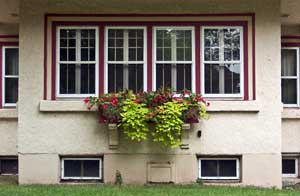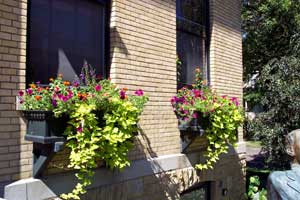Small Home Gazette, Winter 2009
Tips for Creating Successful Window Box Planters

Red begonias in the window box pick up the red trim around the windows.
The popularity of creatively combining different plant materials in window boxes has soared in recent years. Mixing plants of various color, texture and plant habit to design what, in essence, become miniature landscapes sets one home apart from both the outdoor and indoor vantage points.
Having and designing window boxes can become a very creative and rewarding endeavor. The diversity of plant materials to choose from and effects that can be generated seem almost limitless. Familiarity with the cultural needs and growth habits of different plant species and cultivars can go a long way to better choose combinations that will work well over the long run.
Group Plants With Similar Cultural Requirements
Light
Combine plants that share similar light requirements. Plants that do well with half a day or more of full sun include ageratum, marigold, petunia and zinnia. Plants that need to be shaded most of the day include common impatiens, tuberous begonias and fuchsia. Higher and lower light-requiring plants can sometimes be successfully combined. For example, combine larger, higher light-requiring plants that cast shade with smaller, shade-tolerant plants
Temperature preference is often closely allied with light requirement. Heat loving annuals like gazania and moss rose also prefer full sun and are more tolerant of drying out.
Water
Combine plants with similar moisture needs. Plants that can tolerate or prefer being kept on the dry side include gazania, moss rose, verbena and zinnia. Those that prefer to be kept on the moist side include coleus, tuberous begonias and fuchsia.
pH
Often not thought about, the pH of the growing medium influences nutrient availability and other aspects of plant growth. In addition to the starting pH, pH can change over time in response to water quality and type of fertilizer used. Often the pH of city water is elevated to a pH of over 7.5 with sodium hydroxide or other bases to protect metal pipes from slowly deteriorating. High water pH can elevate soil pH over time.
Knowing your pH will aid in selecting better adapted plants. For instance, geraniums, celosia and marigolds prefer a higher pH and petunia, pansy and bacopa a lower pH. It often becomes clear in mixed plantings of, for instance, petunia and geranium if the pH is shifting more towards the acidic or alkaline side based on which is performing better.
Combine Plants Considering Their Growth and Flowering Traits
Vigor
Using plants with similar growth rates helps to prevent slower growing plants from being smothered by vigorous neighboring plants. A very vigorous spreading petunia cultivar, for instance, may choke out a neighboring compact-growing ageratum or geranium. One factor that influences growth rate is response to fertilization. Many of the more expensive, specialty annuals like spreading petunias, bacopa and sun coleus, for instance, are heavy feeders and can grow quickly in a nutrient-rich environment.
Growth habit
Some plants have looser, more open, airy growth habits and tend to intermingle and flower better with each other, while other plants have denser growth and more difficulty growing with other plants. Growth habits also vary between upright, mounding or trailing. Loose-growing trailing verbena and bidens cultivars can intermingle and flower well together, while geraniums, tuberous begonias, spreading petunias and bacopa cultivars tend to make a thick, mounded plant or a relatively dense mat of growth capable of crowding out neighbors. Upright, taller growing plants are often placed towards the center or back of a container, while spreading or trailing plants are placed near the edge of the container where they can grow over the container’s edge. Understanding growth patterns of plants can help in determining placement in the window box and how close to plant different species so each is showcased, not smothered.
Flowering time
Some plants flower continually, while others have more limited periods of bloom. For instance, osteospermums (cape or sunscape daisies), snapdragon and pansies reduce or stop flowering during the heat of summer, but flower again once the temperatures cool down. Mixing plants so that something is blooming at all times during the season can help enhance season-long beauty.
Vast Plant Selection Options
Annuals

Purple petunias, orange zinnias and purple angelonia provide color at the top of these window boxes. Chartreuse sweet potato vine spills over the edges.
Annual bedding plants are traditionally used for window boxes since plants are typically discarded after each season and replanted in the spring. For many traditional annuals there are newer, compact versions of old favorites that are more amenable to confined spaces. For instance, the Profusion series of zinnias are more compact and fit confined spaces better than the old fashioned taller zinnias. The Profusion and Pinwheel series of zinnias are crosses between the small, disease-resistant Mexican zinnia (Zinnia angustifolia) and the traditional large-flowered garden zinnia (Z. violacea, and Z. elgans).
Perennials
Many plants used as annuals in Minnesota are actually perennials in their native climate. Examples include geraniums and fuchsias. Also consider using hardy Minnesota garden perennials in containers. At the end of the season they can be nestled into a perennial bed to extend their value, or discarded as an annual. Frequently used perennials for containers include lamium plants (Lamium maculatum, L. galeobdolon), which are low and spreading with varigated foliage that looks great even when not in flower, as well as golden-leaved creeping Jenny or moneywort (Lysamachia nummularia ‘Aurea’). Compact versions of standard perennials that have a long flowering season make great choices as well and include astilbe ‘Sprite,’ heliopsis ‘Tuscan Sun’ and scabiosa ‘Butterfly Blue.’
Woodies
Compact versions or carefully pruned specimens of an ornamental woody plant can make a great accent or focal point in a container. Some woody plants have especially interesting flowers, foliage or texture. Potential options include the new compact, variegated weigela, ‘My Monet,’ and pruned dappled willow (Salix integra ‘Hakuro Nishiki’).
Uncommon foliage
Foliage color, shape, texture and size all can add unique elements to a design, even if the plant never blooms. In addition to foliage plants such as dusty miller, coleus, alternanthera and dichondra, consider using herbs and vegetables with interesting foliage color and texture such as fennel, parsley and rosemary. Gold, purple-black and variegated cultivars of ornamental sweet potatoes have become very popular and are quite versatile in containers. One consideration with sweet potato is that in relatively small window boxes, the tubers it produces can easily crowd out other plants as the season progresses.
Creating one or more window boxes dedicated entirely to herbs is also a great option, especially window boxes conveniently located outside a kitchen window.
Basic Container Garden Growing Recommendations
Make sure window boxes have holes for drainage and also are a suitable size to accommodate your chosen plants as they grow throughout the season. Often, too small a container is chosen or too many plants are put in a container which leads to overcrowding problems by midsummer. Look beyond how full, colorful and proportional the plants look at planting time and envision the container and size of the plants a few weeks later and throughout the rest of the growing season.
Potting media need to have a balance of both moisture retention as well as porosity so oxygen can get to the roots. If the medium does not have good aeration and frequently becomes waterlogged, roots can be deprived of oxygen, slow in growth, and likely to rot. On the other hand, a medium that is too porous can be challenging to water frequently enough to keep moist. Most standard, suitable mixes for containers are high in organic matter (often containing peat moss, compost and/or bark) and may contain perlite or vermiculite for added porosity.
One option many use is to place a series of potted plants into an empty window box. This allows flexibility to replace plants and to have a spot to set some plants that typically serve as houseplants during the summer months.
Containers can dry out quickly, especially on hot windy days and after plant materials grow and their demand for moisture increases. To help with watering needs, leave at least half an inch from the surface of the media to the rim of the container when planting. This will provide space for water to puddle and then slowly soak in without quickly running off.











